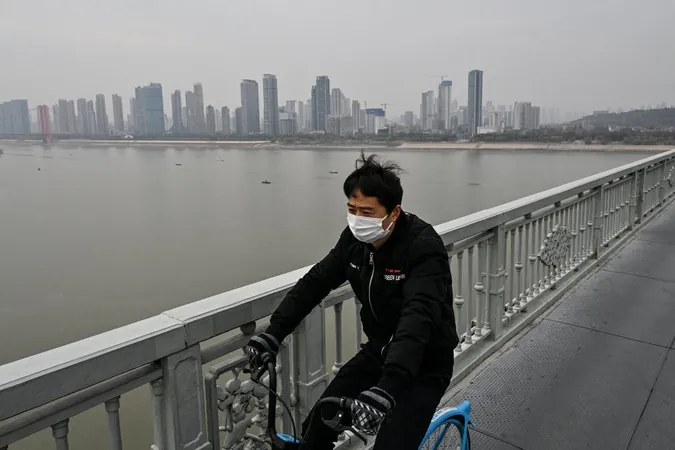
What is HMPV? China Heightens Vigilance as New Respiratory Virus Surges!
2025-01-06
Author: Chun
China's Current Situation with HMPV
China is currently witnessing a sharp rise in infections of a respiratory virus known as human metapneumovirus (HMPV). This uptick has led to overcrowded hospitals and heightened public anxiety, reminiscent of the early days of the COVID-19 pandemic.
Reports indicate that HMPV cases are surging particularly among children in northern provinces this winter. The emergence of this virus comes five years after the alert was raised regarding the novel coronavirus in Wuhan, which eventually resulted in a global pandemic claiming over seven million lives.
Images and videos circulating on social media showcasing hospital scenes filled with masked individuals have sparked comparisons to the earlier COVID-19 outbreak, intensifying fears among locals. In response, health authorities have rolled out new monitoring measures to manage and track the spread of pneumonia cases, although officials in Beijing have portrayed these developments as a typical winter epidemic.
Mao Ning, spokesperson for China’s foreign ministry, remarked, 'Respiratory infections tend to peak during the winter season. The diseases appear to be less severe and spread on a smaller scale compared to the previous year,' attempting to downplay the extent of the outbreak.
Understanding HMPV: The Facts You Need to Know!
Human metapneumovirus (HMPV) is a respiratory virus causing symptoms akin to the common cold or influenza. Although HMPV generally results in mild illness, it can escalate to severe complications like pneumonia in infants, the elderly, and immunocompromised individuals.
Described as a single-stranded RNA virus, HMPV was first identified in 2001 and is transmitted via respiratory droplets or contaminated surfaces. Its typical symptoms, including cough, fever, nasal congestion, and fatigue, can manifest within three to six days following exposure. Notably, unlike COVID-19, no vaccines or specific antiviral treatments are available for HMPV, placing a heavy reliance on symptom management.
Rising Concerns: The Surge in Cases
The recent outbreak correlates with the colder season, when people are more prone to staying indoors—conditions that are well-known to fuel the spread of respiratory viruses. The National Disease Control and Prevention Administration of China has reported increased respiratory infections, including HMPV, consistent with seasonal trends. While the World Health Organization (WHO) has not classified this situation as a global health emergency, monitoring efforts have been intensified.
Chinese health authorities unveiled a pilot program aimed at tracking pneumonia cases of unknown origins, ensuring better reporting and management from laboratories and health facilities across the nation.
Can HMPV Cross Borders? The Global Watch
Hong Kong has already reported a handful of HMPV cases, prompting neighboring countries like Cambodia and Taiwan to remain vigilant. Cambodia’s Communicable Disease Control Department has issued warnings regarding HMPV, emphasizing its structural similarities with COVID-19 and influenza.
Taiwan’s Centers for Disease Control have noted that the virus poses increased risks for children, the elderly, and people with weakened immune systems. Health officials in India, however, have emphasized that there is little cause for alarm, likening HMPV to any other respiratory virus and advising citizens to remain calm.
Dr. Atul Goel from the Directorate General of Health Services in India stated, 'Let me be very clear: metapneumovirus is like any other respiratory virus which causes the common cold. It could cause flu-like symptoms in the very old and the very young.'
Stay Informed! Protect Yourself!
As the world keeps a watchful eye on this latest surge, experts encourage public awareness and hygiene practices to help curb the spread of HMPV. Early detection and reporting remain crucial to managing this new respiratory virus effectively.






 Brasil (PT)
Brasil (PT)
 Canada (EN)
Canada (EN)
 Chile (ES)
Chile (ES)
 Česko (CS)
Česko (CS)
 대한민국 (KO)
대한민국 (KO)
 España (ES)
España (ES)
 France (FR)
France (FR)
 Hong Kong (EN)
Hong Kong (EN)
 Italia (IT)
Italia (IT)
 日本 (JA)
日本 (JA)
 Magyarország (HU)
Magyarország (HU)
 Norge (NO)
Norge (NO)
 Polska (PL)
Polska (PL)
 Schweiz (DE)
Schweiz (DE)
 Singapore (EN)
Singapore (EN)
 Sverige (SV)
Sverige (SV)
 Suomi (FI)
Suomi (FI)
 Türkiye (TR)
Türkiye (TR)
 الإمارات العربية المتحدة (AR)
الإمارات العربية المتحدة (AR)